Within the last few months, one of the most interesting questions in European football was which club Erling Braut Haaland would join.
It was clear that he would leave RB Salzburg either in the winter transfer window or at the latest in the summer of 2020, but since he showed so outstanding performances several clubs wanted to sign him already in January.
After all, he now joined Borussia Dortmund and due to that RB Salzburg lost another important player.
In this tactical analysis in the form of a scout report, we’ll look at RB Salzburg’s strikers who will have to compensate Erling Haaland’s departure by investigating shortly their abilities and tactics.
Statistical comparison
Salzburg’s coach Jesse Marsch likes to use different systems and rotate (especially in weeks when they have to play in an international competition).
Anyways, he always lines his team up with two strikers upfront.
He prefers a 4-4-2 formation, but we saw this season Salzburg already with a 4-diamond-2 or a 3-5-2 system.
Considering this, it’s not possible to compensate Haaland’s transfer with one single player as the American coach always wants to have two strikers upfront.
Anyways, the Austrian club have got even after the move of the Norwegian star still four strikers in their squad: Patson Daka, Hee-Chan Hwang, Sekou Koita and Smail Prevljak.
Besides, they ended the loan of the two forwards Anderson Niangbo (Wolfsberger AC) and Mërgim Berisha (Altach) during the last few days.
In the table below we can see a statistical comparison of Haaland and the other six men.
Since the seven players had different numbers of appearances and logically got subbed on and off several times, the stats are their average values per 90 minutes.
The numbers are for the opening 18 games of this Austrian Bundesliga season.

When we look at the table, we can see that Haaland is the most dangerous in front of the goal while Prevljak is the one with the worst goalscoring rate what is logical since he clearly played the fewest minutes.
We can also notice that Hwang is the forward who has the best playmaking abilities (passing and dribble) as he is the best in both categories.
We’ll now shortly look at each player and their style of play.
Patson Daka
Daka is maybe the player who fits better into Salzburg’s system and tactics than any other striker in Salzburg’s squad what we also saw in his statistics as he scored until now 14 goals and provided three assists.
However, he is no classic striker who permanently stays high up the pitch and waits for his teammates to deliver him good crosses or to receive a perfect through pass.
Instead, he permanently looks for free spaces in which he could position to receive a pass and get involved.
More than any other play in Salzburg’s current squad, he’s incredibly dangerous in front of goal as we could see in the table above.
Besides, his intelligent movements don’t just help him to exploit his acceleration and pace, but also opens up spaces for his teammates as we can see in the example below.
Daka’s vertical run helps his striking partner Prevljak as it creates space for him.
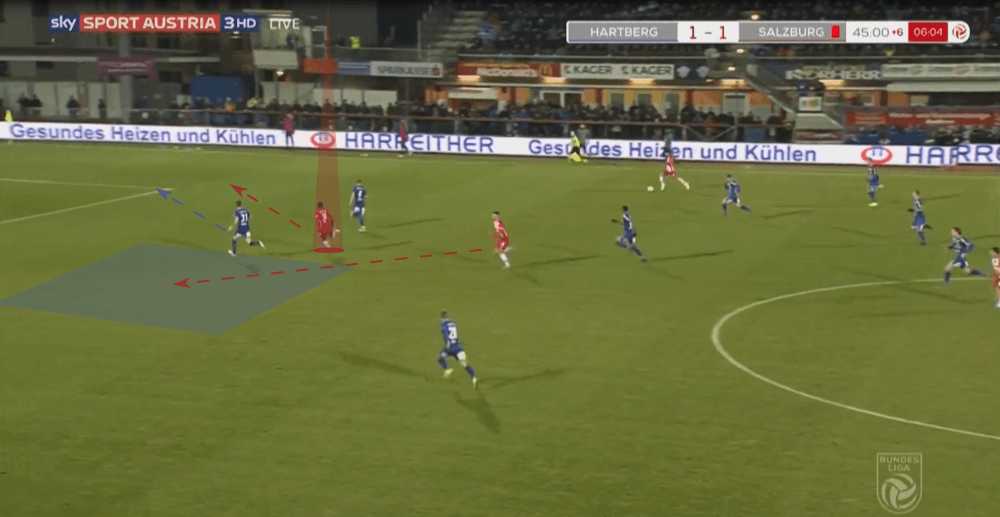
Even though Salzburg is a team which want to dominate the opposition with possession and create goalscoring chance after goalscoring chance with the aid of short passing combinations, they don’t hesitate to play long balls.
Firstly, with such long balls behind the last line of the opposing defence, they can perfectly exploit the speed of their offensive players like, Daka, Hwang, Koita or Masaya Okugawa and besides it’s a good way to start a counter-pressing for which the Austrian side is famous for.
Due to that, one of the qualities which almost all attacking players of Salzburg have, is that they are incredibly fast and agile as we’ll see in the other parts of this analysis too.
In the shot below, we can see Daka and Haaland upfront while the captain Andreas Ulmer is on the ball in a deeper position.
Haaland makes a vertical while Daka is on his way to the other side to run into the free space which he detected.
However, Ulmer recognizes it too late and has to play a short pass instead, but this image shows a typical example for Daka’s movements in the higher lines as he often looks for free spaces to receive through passes.
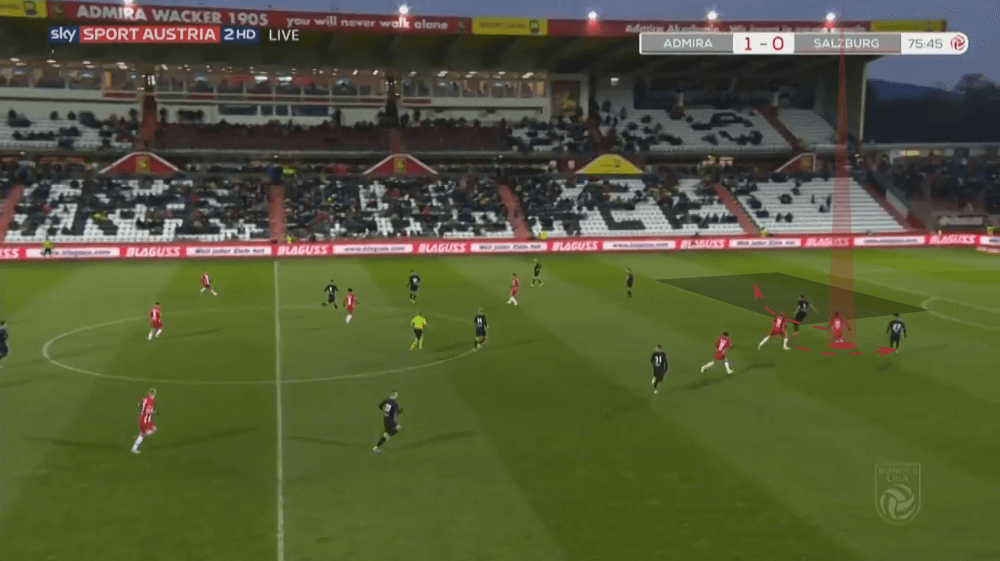
Hee-Chan Hwang
The South Korean was in the season 2018/19 away on loan at the Hamburger SV but couldn’t show his real potential there.
At the end of that season, his market value was £2.70million while it is now £11.25million.
This is just a way to show in numbers what an incredibly good season Hwang had until to this point.
He was besides Daka and Haaland clearly Marsch’s favourite strike in the squad and since the Norwegian star had to fight with several injuries, Hwang made as much appearances (14) as Haaland.
As already mentioned above in this tactical analysis and as we saw in the stat table, Hwang is the striker in RB Salzburg’s squad whose characteristics look more like they were from an offensive or central midfielder.
His passing and dribble statistics are quite impressing as in both categories his success rate is clearly higher compared to the ones of his teammates.
55.9% of his dribbles are successful while 75.3% of his passes were received by a teammate.
His abilities on the ball combined with his speed and acceleration make it extremely hard for the opposition to defend against him.
Especially Hwang and Minamino harmonised great together since both men are strong on the ball and love to have little give and goes.
Such an example can be seen in the shot below as Minamino and Hwang create together against Liverpool’s defence an incredibly dangerous situation.
Hwang makes use of his fascinating speed to get into free space and his Japanese teammate perfectly lays off the ball for him.
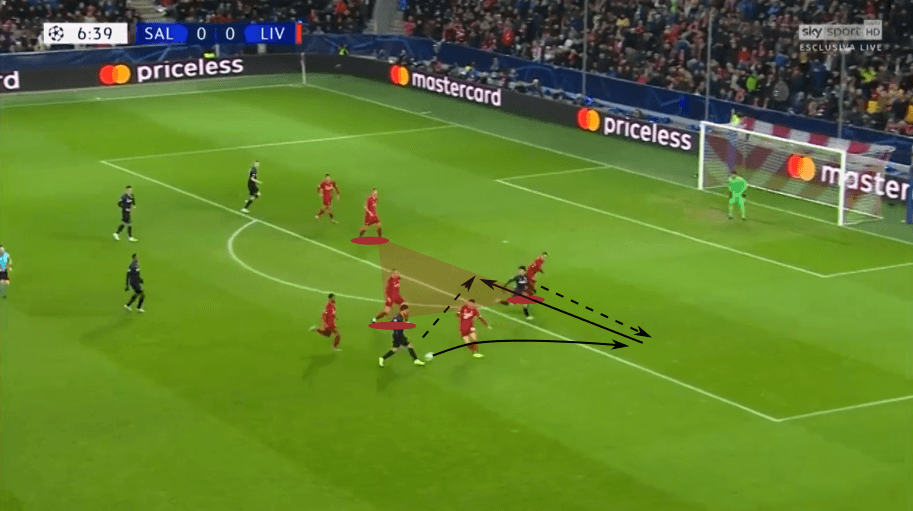
However, Hwang is also able to beat the opposition’s defenders alone due to his speed and ability to dribble with the ball close to his feet.
Especially his acceleration helps him in such situations as we can see in the example below.
He receives a pass from Minamino and starts with his first touch a dribble to exploit the space ahead of him.
Due to his speed combined with his technical ability, the South Korean is able to get past Napoli’s defender to get in front of the goal.
However, we then witness that he is for a striker not that efficient in front of the goal as he doesn’t even hit the goal with his shot.
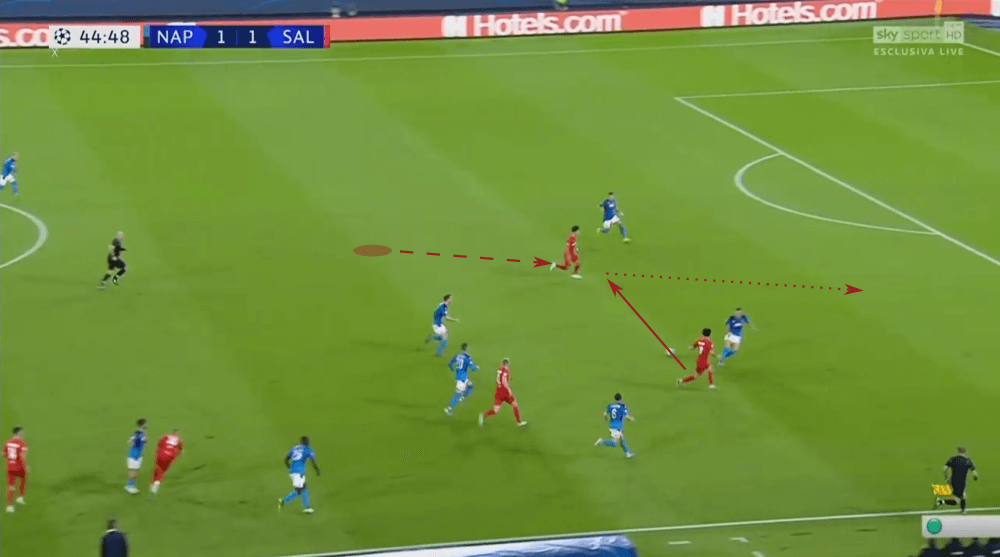
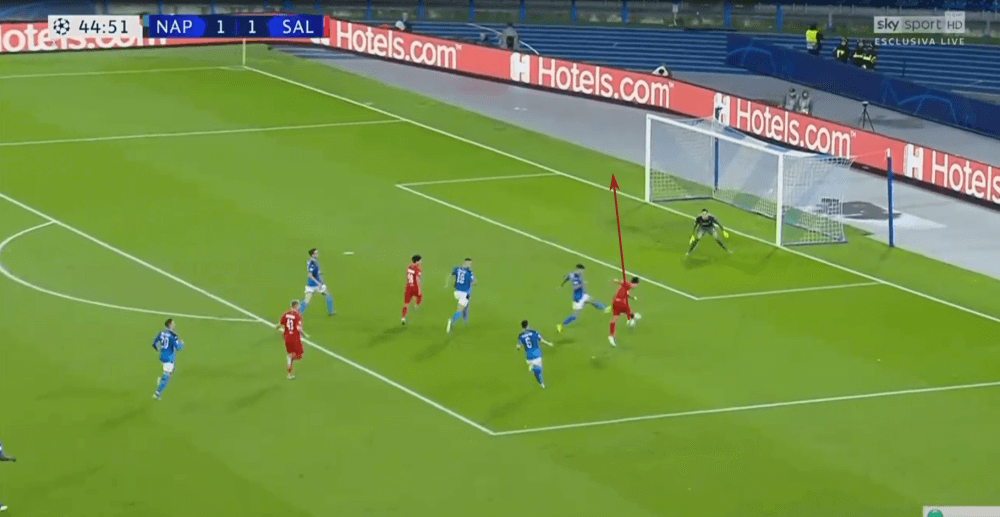
Anyways, Hwang really needs to work on his ability to convert chances into actual goals.
Sekou Koita
Koita is now the youngest striker in RB Salzburg’s squad after the departure of Haaland.
The 20-years-old man from Mali already scored six goals and provided three assists in just 10 appearances in this season in the highest division of Austria.
However, Koita didn’t just play as a striker in this season as he also was a winger in some games.
Since the 20-years-old is also really fast as the two already analysed players this makes quite a sense and besides it seems as he feels confident on the wing as he also likes to position in the wide areas when he plays as a striker.
In general, Koita is a player who loves to dribble and permanently looks for a one-on-one situation to beat the defender and what also explains why he starts 5.82 dribbles per game.
However, a success rate of just 20.6% also shows that he’s not that efficient when it comes to dribbles.
This isn’t because he hasn’t the technical abilities, but because he often doesn’t know when it is the right moment to pass the ball to a teammate.
Besides, he’s sometimes not efficient at all as we can see in the example below.
He gets into a perfect one-on-one situation with his opponent but makes too many oversteps and loses the ball instead of looking for a chance to shoot or to pass the ball.
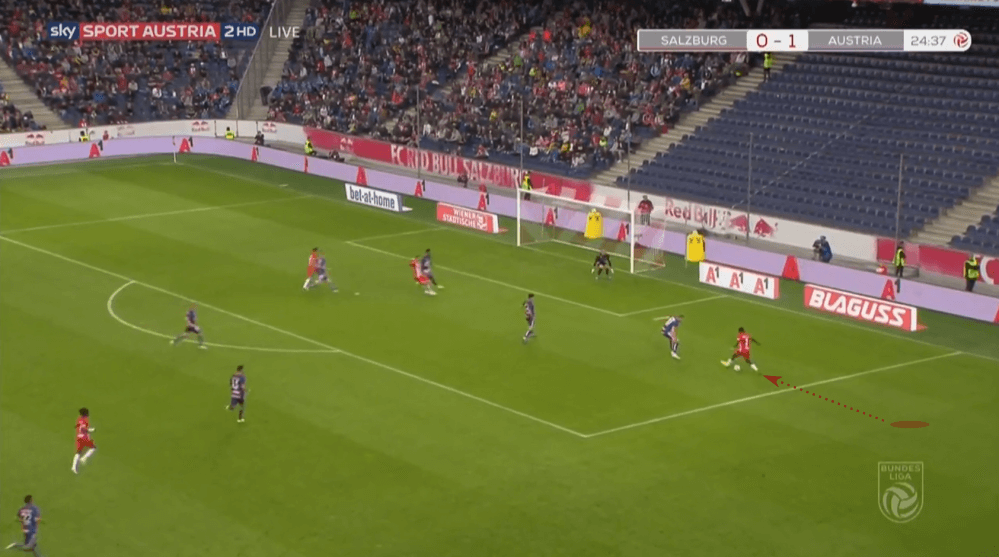
However, his values also tell that he is quite dangerous in front of the goal when he gets there as he scored until now 1.03 goals per game compared to an xG of 0.51.
Furthermore, he already provided three assists in this season.
In light of this, he must have good decision-making as soon as he gets into the final third and that’s definitely the case.
Even though he often stays too long on the ball as we already saw in this tactical analysis, he plays the ball to a teammate when this one is really completely free as it can be seen in the example below as Haaland is unmarked.
Koita finds him with a perfect low cross, but the Norwegian misses the chance.
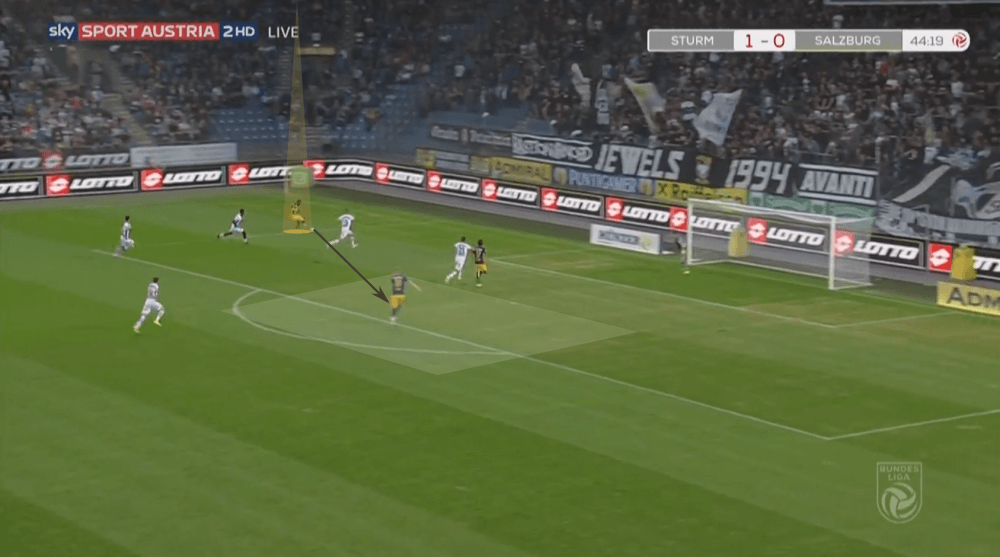
Also, notice in the shot above that Koita is once more in one of the two wide-areas on the ball as he likes to drift to the outside since he can get there easily in situations where he can utilise his speed and abilities on the ball.
However, the fact that he’s among the fastest players in RB Salzburg’s squad also helps him when he is positioned more centrally as a striker.
His teammates then can find him with through passes behind the last line of the opposing defence to exploit his acceleration and speed.
The shot below is a perfect example as Mohamed Camara just has to play a simple vertical through pass, Koita beats the defender to the ball to finish with a low shot to score.
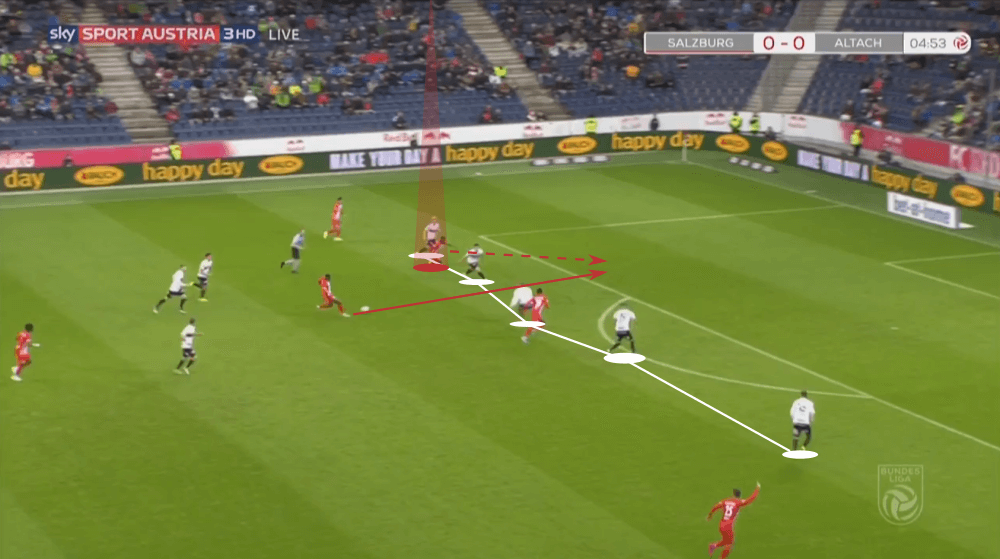
Smail Prevljak
While the three already analysed players in this scout report are not that tall and extremely fast, the next striker in RB Salzburg’s team at which we’ll look now is a completely different type of player.
Prevljak stands at 6’ 16” and is clearly taller than the other three players and Niangbo too.
Only Berisha is almost as tall as Prevljak (6’ 1”).
However, the 24-years-old from Bosnia-Herzegovina is still quite fast for his size, but logically his style of play is different and due to that he doesn’t fit that well into RB Salzburg’s tactics.
While Daka, Hwang and Koita permanently start deep runs or drop a bit deeper to get involved in the build-up, Prevljak mostly stays on the height of the opposition’s centre-backs like a classic striker.
In such situations, he tries to make use of his physical strength and put his body in front of the opponent to be a possible passing option for the midfielders.
This can be perfectly seen in the example below.
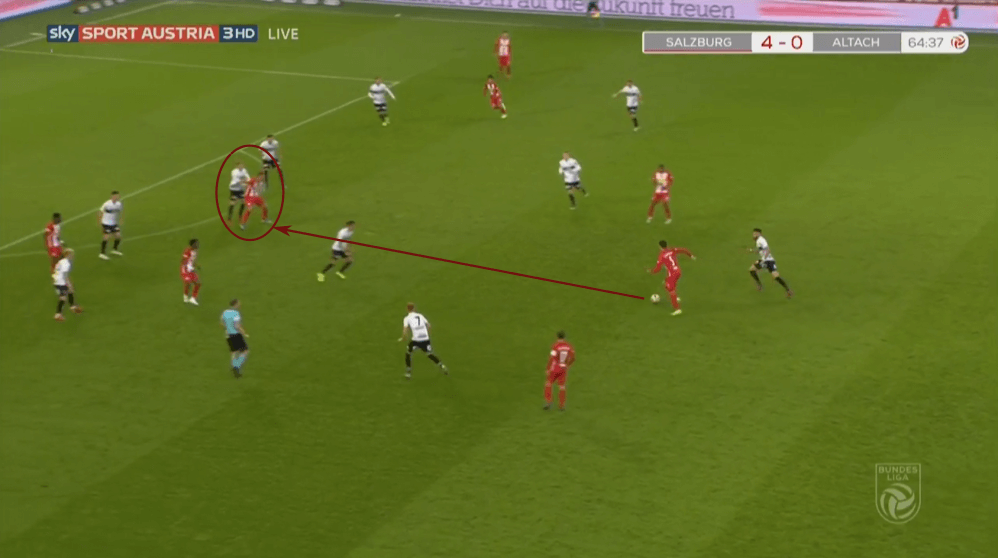
Since the 24-years-old forward isn’t the right player for long balls behind the opposing defence or through passes in general, it’s hard for him to get into goalscoring situations.
Salzburg focus on their vertical style of play and due to that it’ not easy for him.
Furthermore, he played in this season in just four games in the Austrian Bundesliga and considering this, he can’t perform on the highest level.
However, he scored one goal in this season and ahead of that you truly saw his real strengths.
He received the ball in the penalty box and was able to put his body between the ball and his opponent to shield the ball.
Besides, Prevljak has a decent technique and he brought himself in a good position to fire an incredibly strong shot under the crossbar.
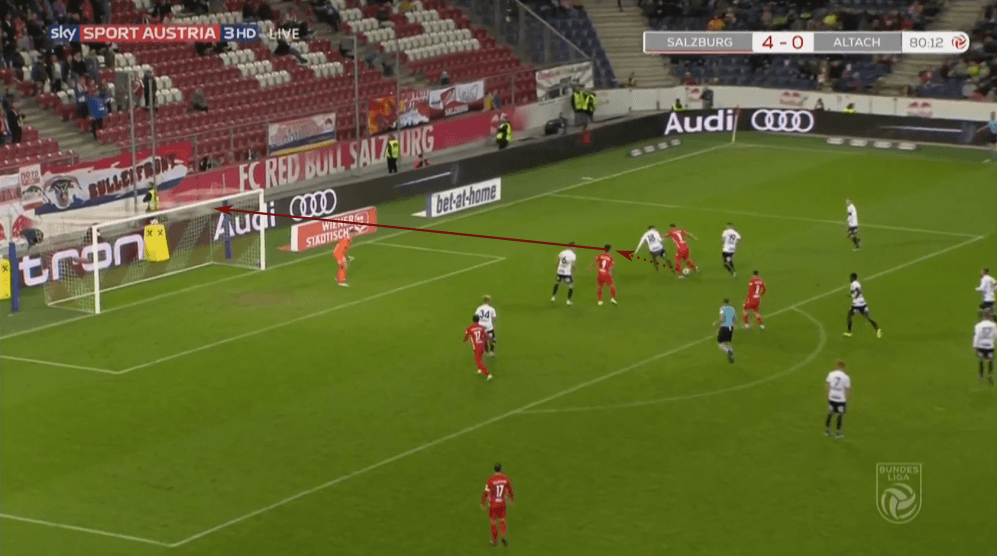
Additionally, you have to mention that since the 24-years-old is such a different type of player compared to Daka, Hwang and Koita, he gives RB Salzburg other options when they’re in position.
He can be a target for long balls which don’t go down behind the opposition’s defence, but in the space between the defence and the midfield.
Furthermore, he is the perfect player to convert a cross into a goal while it’s hard for the other attackers to win aerial duels in the opposition’s penalty box.
Due to that, Prevljak always positions himself in the box when Salzburg is on the wing in possession while the other strikers also like to drop a bit deeper.
This can be seen in the shot below.
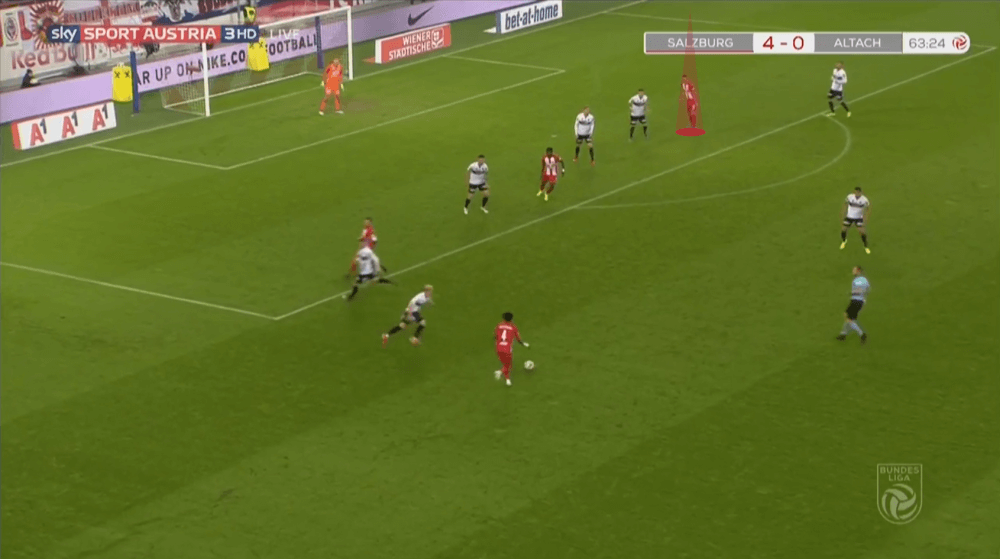
Anderson Niangbo
The young Ivorian isn’t a classic striker since he also likes to position in the wide areas where he can make more use of his incredible speed (similar to Koita).
Niangbo likes to receive either through passes or go into one-on-one situations with an opponent since then he can utilise his acceleration and sprint speed.
Due to that, the young striker showed this season at Wolfsberg already that he often positions on the wing to then receive a through pass.
At this club, this was possible since Wolfsberg mostly used a 4-3-1-2 formation with Niangbo and Shon Weissmann upfront.
Since Weissmann is a striker who mainly stays in the middle and near the opposition’s centre-backs, the Ivorian could easily drift to the left-wing since the centre would still be occupied by his partner.
Besides, Niangbo also likes to drop deeper to get involved in the build-up and receive the ball.
Anyways, he has a similar problem as Koita as he often misses the right moment to pass the ball and stays too long on it.
He has the technical abilities to dribble past numerous defenders, but he needs to learn that it is sometimes more effective to pass the ball to a teammate than trying it on his own.
To get on the ball more often and start dribbles, the young Ivorian likes to drop into one of the half-spaces as it can be seen in the image below.
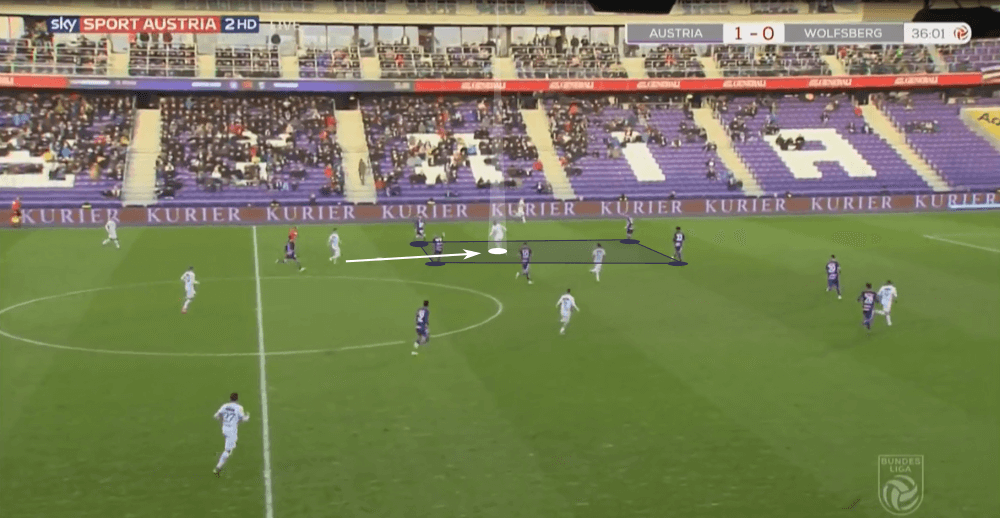
However, at the first glance, it looks like Niangbo would perfectly fit into the tactics of RB Salzburg as he is strong on the ball, dangerous in front of the goal and besides is really fast.
As we already saw in this tactical analysis, especially the last point is important for the tactics of the Austrian champions since their style of play is very vertical.
Niangbo is aware of his speed and tries to exploit it as often as possible with deep runs.
No matter if on the wing or in the centre as we can see in the two shots below.
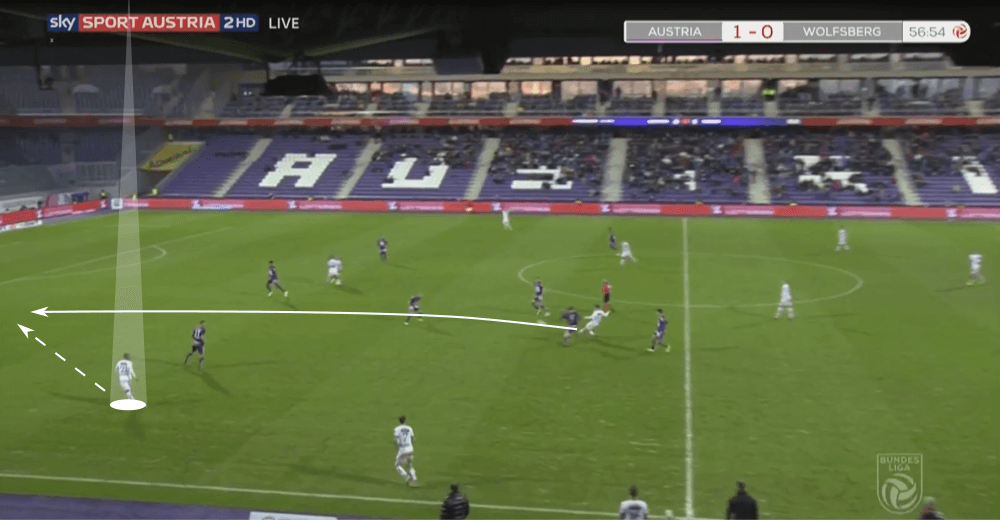
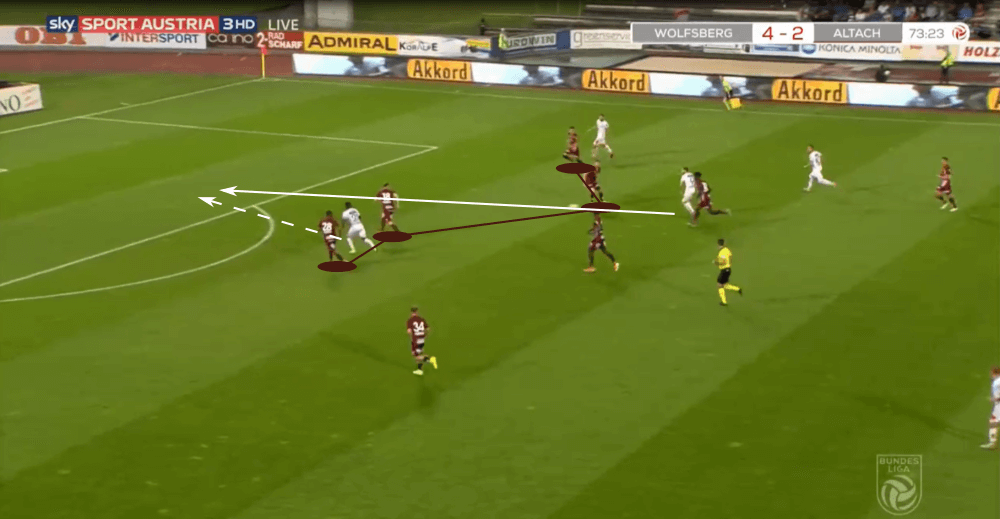
Mërgim Berisha
First of all, you have to admit that in this season Berisha played for a weaker team than the other five men.
Daka, Hwang, Koita and Prevljak made all their appearances for RB Salzburg while Niangbo played for Wolfsberg.
Salzburg are at the moment the league leaders while Wolfsberg sit in the fourth position.
However, Altach is in eighth place and are clearly not that good as the other two teams.
This also made it quite hard for Berisha to score goals since he didn’t get that often in goalscoring situations.
Altach had in this season on average 10.4 shots per game while RB Salzburg had logically the best value of the league with 18.03 and Wolfsberg shot 15.45 times per game.
So, these numbers show that Berisha had it as a striker not that easy at Altach.
However, he still managed to score seven goals and provide five assists in 17 games.
The interesting aspect is that he’s 6’ 1”, so just a few inches smaller than Prevljak, but a completely different type of player.
Even though he’s such a tall striker, he doesn’t just stay in the centre and waits for crosses or long ball towards him as Prevljak often does.
Instead, he also likes to drop deeper to get involved and looks for free spaces to position in as he does in the shot below.
In such deeper areas, he can easily collect the ball to make use of his ability to dribble with the ball.
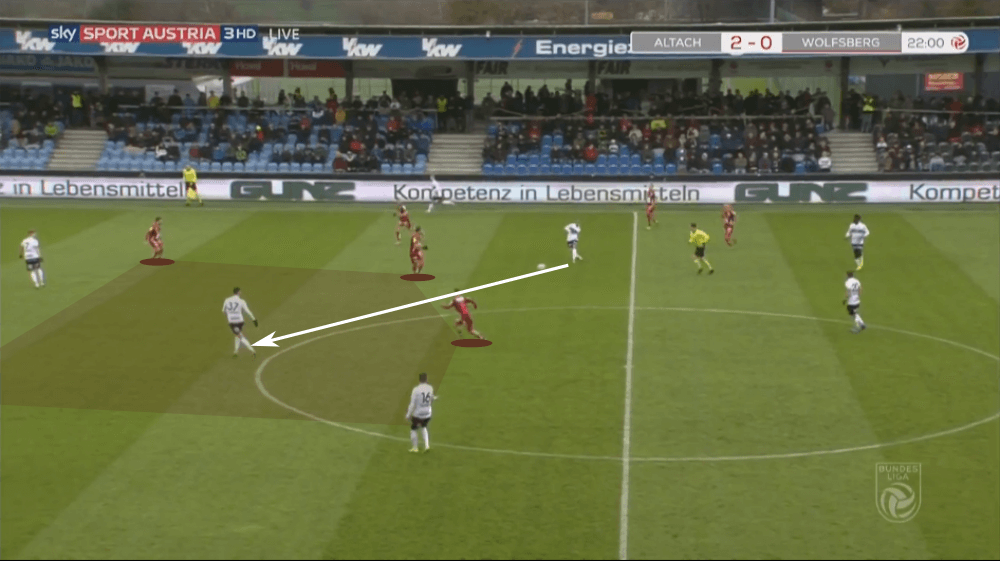
Besides, the German striker is also a player who quite often drifts to the outside and he can deliver from there great crosses.
Three of his five assists in this season were low crosses into the centre what shows that he likes to position in the wide-areas to then create goalscoring chances by crossing the ball into the centre.
Besides, one of Berisha’s greatest strengths is that he can shoot with both feet extremely well.
This gives him a lot of options since he doesn’t need to always get the ball into the right position to shoot with his strong foot since he can do it with both feet.
Besides, he’s a forward who always tries to get as soon as possible into a good shooting position when he receives the ball near the penalty box as it can be seen in the image below.
He receives a pass and instantly wants to exploit the gap between the two defenders with his first touch as he does.
He then fires the ball underneath the crossbar to give the goalkeeper no chance at all.
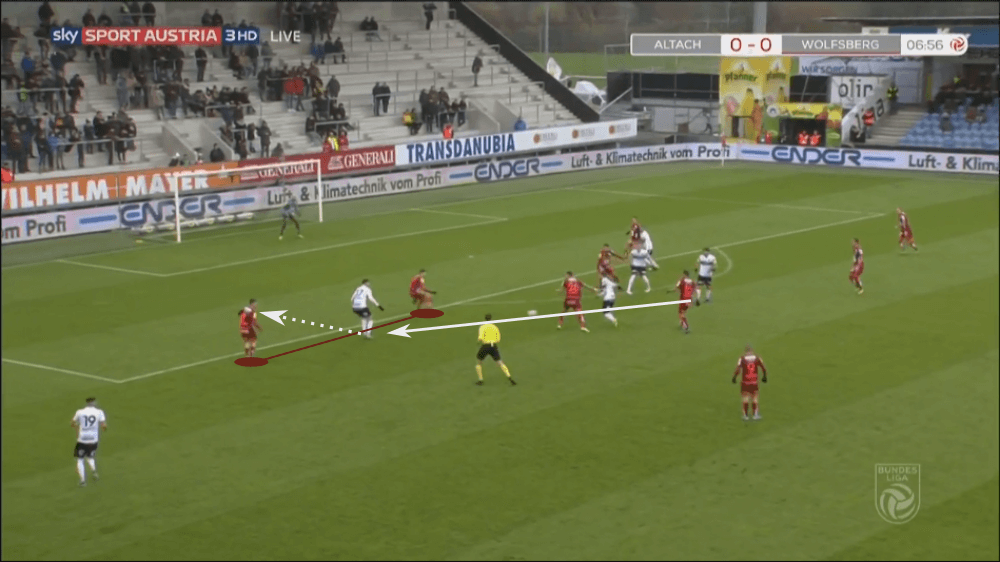
Conclusion
In general, RB Salzburg have clearly enough depth in their squad to compensate for the departure of Haaland.
They had four good strikers in their team, but since they now also brought back Niangbo and Berisha, Salzburg have six strikers what are quite a lot.
However, it will be interesting to watch how much time Niangbo and Berisha will get since it was usually planned that they should return in the summer but since RB Salzburg lost with Haaland their most important striker, they decided to end the loan of these two forwards.
Anyways, Daka is surely the one who will play most of the time, but it will be interesting to watch how Marsch will manage to give each one of the six strikers enough time on the pitch.
But since they are still in the UEFA Europa League, they will have to rotate anyway and we’ll see who will get the most minutes on the pitch and who will be the new top scorer of the Austrian champions.





Comments